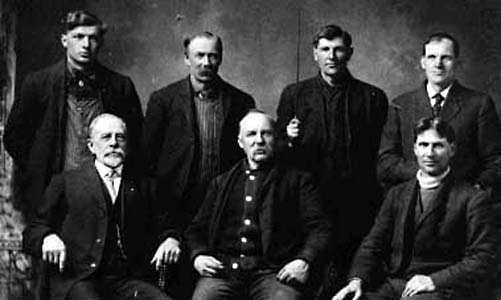Search | Image Archive | Reference | Communities | POV | Lesson Plans | Credits
 The town of Hartney took its name from James Hartney, a wealthy Ontarian who in 1881 purchased two full sections (the equivalent of eight farms) along the Souris River and hired workers to plough the fields a year before he arrived with his family and servants in 1882. While Hartney was certainly not typical of the settlers the district, he reflected in great part the aspirations of the residents of this largely Ontario-born farming community.
The town of Hartney took its name from James Hartney, a wealthy Ontarian who in 1881 purchased two full sections (the equivalent of eight farms) along the Souris River and hired workers to plough the fields a year before he arrived with his family and servants in 1882. While Hartney was certainly not typical of the settlers the district, he reflected in great part the aspirations of the residents of this largely Ontario-born farming community.
By 1900, the small communities south of Brandon in the Souris River Valley were among the most prosperous in the west. The earliest settlement was in the valley itself, where there was good soil wood for building. As the decade wore-on and the sections along the river were filled, some settled on the dry prairie. Most of the early settlers were Ontarians or Americans who were attracted to Manitoba by the prospect of large farms and inexpensive land. Most were individuals of means, with the necessary capital to purchase the equipment necessary to manage a large farm.
Their arrival in the 1880s, however, was not greeted with immediate prosperity. With the exception of few aboriginal farmers along the rivers, the area was empty, and for good reason. Farming methods practiced in the east were unsuited to the semi-arid condition of the prairie soils, and, without the knowledge to conserve soil moisture, many farms failed and many farmers abandoned their farms for land in the moister park belt in the Dauphin and Swan River Valleys.
By the turn of the century, many of the problems of dry-land farming had been solved. Summer fallowing had been introduced as a means of conserving soil moisture, and the precise planting of the seed drill ensured even germination. Many of these innovations were the responsibility of the farmers themselves, who devoted considerable effort to the study of scientific agriculture.
By 1900, farming had become a capital intensive and highly mechanized effort, and many farmers would have identified themselves as professionals. Beginning in the 1880s, steam engines appeared with growing frequency pulling ploughs or driving threshing machines, although horses and oxen were still in use on every farm. By the second decade of the new century, these machines were being replaced by gasoline engines. In this same period the advent of the automobile began change the district.
The people of the Hartney area were united by occupational and ethnic bonds. Many were firmly rooted in the Anglo-protestant culture of the east, and they imported many of its sensibilities and customs with them. A large part of the social life of the district revolved around the enterprise of farming, and agricultural societies and the rural Women's Institutes played a significant role in shaping the identity of the community.
Page revised: 29 August 2009